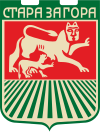Stara Zagora
|
Stara Zagora Стара Загора |
|||
|---|---|---|---|
|
|||
| Nickname(s): The city of the linden-trees | |||
| Location of Stara Zagora | |||
| Coordinates: 42°26′N 25°39′E / 42.433°N 25.650°ECoordinates: 42°26′N 25°39′E / 42.433°N 25.650°E | |||
| Country | Bulgaria | ||
| Province | Stara Zagora | ||
| Established | 342 BC | ||
| Government | |||
| • Mayor | Zhivko Todorov [GERB] | ||
| Area | |||
| • City | 85.786 km2 (33.122 sq mi) | ||
| Elevation | 196 m (643 ft) | ||
| Population (2015) | |||
| • City | 158,563 | ||
| • Density | 1,612/km2 (4,180/sq mi) | ||
| • Urban | 136,807 | ||
| Time zone | EET (UTC+2) | ||
| • Summer (DST) | EEST (UTC+3) | ||
| Postal Code | 6000 | ||
| Area code(s) | 042 | ||
| Website | www.starazagora.bg | ||
Stara Zagora (Bulgarian: Стара Загора, pronounced [ˈstarɐ ˈzaɡorɐ]) is a city in Bulgaria, a nationally important economic center. Located in Southern Bulgaria, it is the administrative capital of the homonymous Stara Zagora Province.
According to Operative Program Regional Development of Bulgaria, the agglomeration of Stara Zagora is the fifth largest in Bulgaria and has a population of 213,444 inhabitants.
Stara Zagora is known as the city of straight streets, linden trees, and poets.
The name comes from the Slavic root star ("old") and the name of the medieval region of Zagore ("beyond the [Balkan] mountains" in Slavic)
The favourable geographic and climatic conditions of the territory around Stara Zagora contributed to the establishment of several prehistoric settlements in the remote past. More than 100 prehistoric mounds from the 6th to 3rd millennium BC were found in the vicinity of Stara Zagora. One of them, the Bereketska mound, is the largest in Bulgaria, containing traces of people that lived there from the New Stone Age (6th millennium BC) to the Middle Ages (12th century). A prehistoric settlement can be found within the city itself. Two dwellings from the New Stone Age are preserved in the Neolithic Dwellings Museum. These are the best preserved dwellings from the New Stone or Neolithic Age (6th millennium BC) in Europe and contain a rich collection of tools and artefacts. The oldest copper mines in Europe (5th millennium BC) were found 8 km (4.97 mi) east of the city, A considerable amount of copper ore was extracted from the 11 mines by the ancient inhabitants of this land who traded with it throughout the continent.
...
Wikipedia



